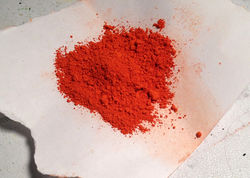Basic lead chromate
 Chrome orange under indoor lighting
| |
| Names | |
|---|---|
| Other names
Chrome orange
Chrome red | |
| Properties | |
| PbCrO4·PbO | |
| Molar mass | 526.46 g/mol |
| Appearance | Reddish-orange solid |
| Odor | Odorless |
| Melting point | Decomposes |
| Boiling point | Decomposes |
| Insoluble | |
| Solubility | Insoluble in most solvents |
| Vapor pressure | ~0 mmHg |
| Hazards | |
| Safety data sheet | None |
| Flash point | Non-flammable |
| Related compounds | |
| Related compounds
|
Lead(II) chromate |
| Except where otherwise noted, data are given for materials in their standard state (at 25 °C [77 °F], 100 kPa). | |
| Infobox references | |
Basic lead chromates, more commonly known as Chrome Orange or Chrome Red, are a group of compounds containing both lead(II) chromate and lead(II) oxide. These compounds found use as pigments for oil paints until increasing concerns about the toxicity of lead largely removed it from consumer products.
Contents
Properties
Chemical
Treatment of chrome orange with nitric acid will yield ordinary yellow lead chromate and lead(II) nitrate. This is useful for recycling chrome orange products if the color turns out unsatisfactory.
Physical
The appearance of basic lead chromates can vary significantly, from pale brown to orange to crimson. All methods of preparation tend to yield a fine and uniform powder that is easily filtered.
Availability
Chrome Orange and/or Chrome Red are unlikely to be found in any consumer products today, save for paints in developing countries that have yet to ban lead in many products. It's more cheaper to prepare this compound yourself.
Preparation
Chrome Orange can be made by several known methods, while considerably less information is known about Chrome Red. The most tried and true method is to create a slurry of lead chromate in boiling water, followed by the immediate addition of solid sodium hydroxide to the solution with heavy stirring, in an amount that is similar in volume to the amount of lead chromate used. The mixture is then decanted into cold water, filtered, and dried. The orange coloration of the pigment is more apparent after briefly grinding it.
Another method is to prepare two solutions, one of lead(II) nitrate, and one of a mixture of sodium or potassium chromate and sodium or potassium hydroxide. Both solutions are heated and then rapidly mixed, though the color produced is not as consistent as the first method.
A final method for the preparation of Chrome Orange is the roasting of a mixture of lead chromate and sodium nitrite in air at high temperature, with careful regulation of the temperature to prevent decomposition of the chromate, which seems to start at about 500 °C.
Projects
- Homemade orange paint (this requires great expertise to work around, as it is VERY toxic)
Handling
Safety
It is very important that basic lead chromates, and all other lead compounds, only ever be handled while wearing proper protective gear due to their inherent toxicity and danger of bioaccumulation. At minimum, gloves and goggles should be worn during the preparation, and the dry chemical should ideally be handled only with the addition of a face mask to avoid breathing in the dust.
Storage
Basic lead chromates should be stored in clearly marked containers out of reach of any person other than an experienced chemist.
Disposal
It is best to deliver toxic heavy metal compounds such as this to a toxic waste disposal facility, but if that cannot be done for a good reason, basic lead chromates can be decomposed by nitric acid to form lead(II) chromate and soluble lead nitrate, which both have their own disposal regulations. It is a good idea to attempt to recycle any lead compounds to prevent discharging them into the environment in any manner whatsoever. Finally, any soluble lead compounds should at the very least be converted to insoluble lead carbonate, and any hexavalent chromium species should be acidified and reduced to chromium(III).